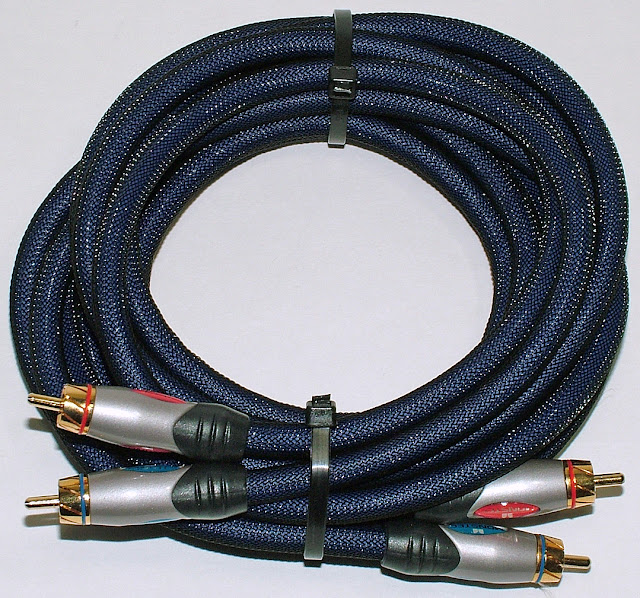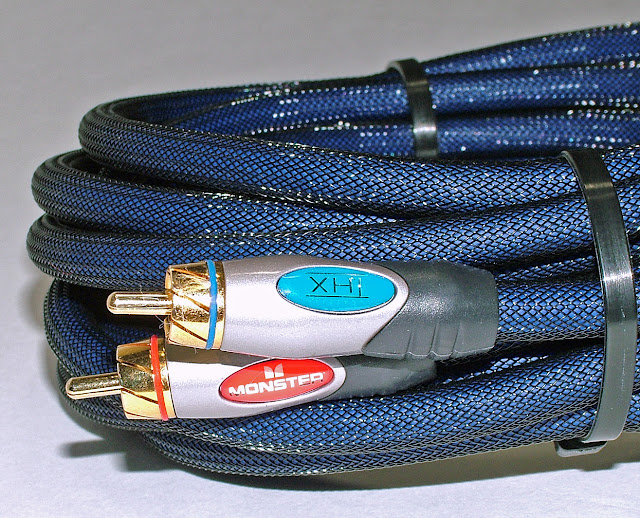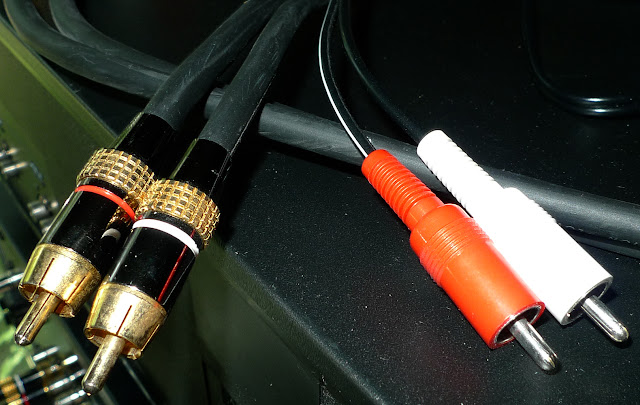August 18, 2018
#270
Gentle reader,
By now, you are likely familiar with my passions which are also my hobbies: Great sounding music reproduction, classic cameras and photography, fun cars. There are more, but those make up the bulk of the 270 chapters I have presented to you, lo these many years. I have YOU to thank for my continuing to produce these blogs. Just the other day, page-views surpassed 175,000. Seems like 50,000 happened not so long ago. So, Thank You!
What we have here are two examples, and not EXTREME ones, of manufacturer's material choices for producing stereo interconnect cables. I say not extreme because there are some REALLY huge and frankly silly examples of cables which cost four or five figures PER METER and weigh a lot too. Why? The thin ones on the right carry the signal just fine. In fact, they sound pretty good. Cable companies have been making them roughly this way since the 1950's. OK, so they may not reject interference all that well, if you're not careful in your routing of these, you might pick up a 60 Hertz hum from power cords or cables. But they do what they are supposed to do.
I have gathered here photos of various cables from several manufacturers, all of which I have tried and most of which I have passed on to others when I found another brand, to me, sounded better.
There was a time when I had setup a six-channel system in addition to the stereo system in the listening room. Since SACDs only output in analog, I needed short cables from the SACD player to the home theater receiver. I do not remember the brand name of these. They are well made and have nice terminals on them. They are 18" long or about half a meter.
Next shown are Liberty Cable's Z-500 Series, their top-of-the-line cables. There was a seller on eBay that did home theater installations and upgrades. He was selling a large number of used, but excellent condition, audio cables as well as Liberty's analog video cables.
As I could afford them, I bought more and more so that I completely outfitted the stereo with these. Our home theater setup received them as well. These are very low capacitance so I still use a half-meter pair to hook my Denon turntable to my preamp.
These are Liberty's Z-500 component video cables. Their capacitance is slightly higher, but they still make excellent audio cables.
Below is one of their Coaxial Digital audio cables. I do not know what, if any, construction difference there is from analog cables.
Below is one of their Coaxial Digital audio cables. I do not know what, if any, construction difference there is from analog cables.
I may be wrong about this, but is seems to me that masses of zeroes and ones streaming through this type of cable is NOT affected by radio and other audible interference. They're numbers! If I am incorrect, please let me know. I truly am curious.
While on the subject, Toslink or Optical digital audio cables are definitely not affected by that type of interference. In fact, I've used completely CLEAR Toslink cables and they transmitted that complicated multi-channel mass of numbers just fine. SO, if some sales person or web site touts all the many layers of shielding they put in their Toslink cables, save your money and buy elsewhere.
Now I'm going to show you some of Monster Cable's excellent interconnects that I continue to use.
They are both the same color of blue, just the flash was closer to the bottom photo, thus they appear lighter. Aside from them being THX Certified, I do not remember their name or model designation. But at least you know what they look like! (They are 800 series, I just remembered.)
Monster makes many levels of quality and price point cables for various uses, analog, digital, subwoofer and speaker cables. Often they number the series, starting with 100.
Below are several examples.
Above are their THX I100 Series. Note the inexpensive grey plastic insulated terminals.
Above are examples of their IDL 100 Digital Coaxial cable. Oddly, they did not use the standard orange collar color that most makers use to denote digital. Note these also have directional arrows.
These are their M350 interconnects. Note their thickness and very high quality terminals.
This is the final Monster Cable photo and they are more model 800s. These are the same type that I continue to use today and are the same as the initially pictured blue ones at the top of my Monster Cable showcase of cables photos.
Above are their Interlink 400 Mark II interconnect cables. Better quality by far than the 100s.
Above are ones that I think are made for car stereo applications. Note the signal directional arrows. Whether there is anything to that, I do not know. Above are examples of their IDL 100 Digital Coaxial cable. Oddly, they did not use the standard orange collar color that most makers use to denote digital. Note these also have directional arrows.
These are their M350 interconnects. Note their thickness and very high quality terminals.
This is the final Monster Cable photo and they are more model 800s. These are the same type that I continue to use today and are the same as the initially pictured blue ones at the top of my Monster Cable showcase of cables photos.
I believe that these are Monoprice brand cables. Fairly well made. Note how they sleeved the pairs with heat-shrink tubing. There are those that swear by Monoprice products, so I thought I'd give them a try. Not great, but not bad either.
Below are Python brand cables. For lesser uses, such as the family room TV setup, these do just fine.
Here are ones which branded AR for Acoustic Research, once a vaunted brand of speaker manufacturers.
Below are Python brand cables. For lesser uses, such as the family room TV setup, these do just fine.
Here are ones which branded AR for Acoustic Research, once a vaunted brand of speaker manufacturers.
These are some no-name ones I came across and decided to give a try. I was unimpressed.
So, what prompted me to write about this now? I have done similar articles in the past and as some of my posts tend to do, it got tongues wagging on FaceBook audio groups. Opinions are like elbows, everyone has some.
Well, as you may know, I have a second stereo in this room which we dubbed our "office" when we bought this house. This room is across the hallway from the listening room. Both were designed as bedrooms, this a child's and the other the master. But previous owner's finished the lower level with a large bedroom which we have always used. Thus it too was a child's room.
I recently bought a Fisher cassette deck, a very nice looking one and as I am listening to it right now, a fine sounding one. I had rediscovered Radio Shack's then-top-of-the-line interconnect cables. I had used them in the past. By swapping these latest ones into this system between the Denon universal player and the Yamaha stereo receiver, I was instantly aware of a huge increase in the size and clarity of the soundstage. I mean, it was profound!
Since then, I have been keeping an eye out for more of them on eBay and snatching them up. I outfitted the Denon to the 42" HDTV I use in here for racing simulations, not that I will watch a movie in my racing seat, but hey, now I can. I bought the Denon player to listen to CDs and SACDs, so was not concerned about video at all. Turns out the HDMI output does not work. Since DVDs are at most 720P, I have found that analog cables work fine. I found some of the same type Radio Shack cables for that purpose.
Then, with this cassette deck, I wanted them for it too. Lo and behold, someone put a three foot pair on eBay and I snatched them up. They arrived today. Again, a profound difference in the sound. To have a cassette player sound SO good is very satisfying. So, with that long introduction, here are the comparison photos.
Then, with this cassette deck, I wanted them for it too. Lo and behold, someone put a three foot pair on eBay and I snatched them up. They arrived today. Again, a profound difference in the sound. To have a cassette player sound SO good is very satisfying. So, with that long introduction, here are the comparison photos.
Above is an overhead view of the cables atop the deck.
Above is the introduction photo. Look at the differences in their sizes and terminal quality in this photo and below!
Above shows them in their new home.
NOTE: See the "LINE OUT" and "LINE IN" on the deck at the very top/left of the photo? I used a paint marker, they have liquid paint in them and one can carefully paint things like raised letters with them. Cassette decks are notorious for having molded terminal markings left the same color as the plastic.
Above and below are the Denon player's connections.
Excellent quality terminals.
Fat rubber things above are ferrule collars. Makers put them on various cables near to where they will connect to a device. They further block radio and other electronic interference. If you did not know that, now you do.
Now, there are times when circumstances preclude one from using high quality (read thick terminals) such as is shown below on my Dynaco PAT-5 preamplifier which is from the 1970's. To my knowledge, please tell me if I am incorrect, no one made cables such as I have shown you back then. I have been told there were good cables, but no photos have been provided by the tellers. All the cables I remember using in the early days were as shown below or even more basic than these.
As you can see, Dynaco spaced the RCA terminals closely, so no thick terminals can be used. That was OK, since I was recreating my first stereo from 1976 and these are similar to what was available back then.
Now, there are times when circumstances preclude one from using high quality (read thick terminals) such as is shown below on my Dynaco PAT-5 preamplifier which is from the 1970's. To my knowledge, please tell me if I am incorrect, no one made cables such as I have shown you back then. I have been told there were good cables, but no photos have been provided by the tellers. All the cables I remember using in the early days were as shown below or even more basic than these.
As you can see, Dynaco spaced the RCA terminals closely, so no thick terminals can be used. That was OK, since I was recreating my first stereo from 1976 and these are similar to what was available back then.
A couple of bonus photographs for you. The last time I was in my local Radio Shack, this was the brand of good cables they were selling:
Note the orange collars which I mentioned previously. Below is a photo of a number of cables which were replaced by TWO HDMI cables:
So, there are definite advantages to digital verses analog at least as far as home theater.
MORE Bonus photos! Below shows how I have managed cable installations. These are over several years and different brands of cables and components.
From three years ago, still mostly blue Liberty Cables with some grey Monster Cables as well. Note how I keep the AC Power cables and cords separate from the signal cables.
A few months later, I upgraded to Monster's 800 series. The speaker cables on the wall are also Monster's: M-Series.
Two years later (2017) all but one pair of Liberty cables are gone, Monster 800s have taken over. One pair of speaker cables (black ones) are Monster's Z-Series. The braided ones are BLE-Designs. A seller on eBay hand braids and builds them. I went with the cheap cables for the cassette deck. I was using thicker ones before. You'll see why below.
A couple of weeks later, I tried going retro and simple, only having what I did forty years earlier: Turntable, cassette deck, preamp and power amp. All the cables at the bottom are what was left over. Oh, and a tall stack of components. No digital equipment then! Technically, I'm not sure how far along cassette decks were. But that JVC is my 3-head favorite. Those two ADCOM units are ACE-515 power conditioners.
Experiment over, I decided to use both turntables but since my preamp only had one phono input, I had to unplug/plug each time, what a PITA. (Pain In The Ass.) I later incorporated an audio/video switch. They are cheap and plentiful and I noticed no difference in sonic quality using it.
As you can see, this is what the system looks like now. It is quite different. Top row is all Panor-era Dynaco equipment: ST-200 power amplifier, QD-2 (update of 1970's Dynaquad) and PAT-6 preamp/tuner. Middle row OPPO universal player atop TDK CD recorder and Nakamichi CD changer. Bottom row is the two Adcom conditioners, stacked and the JVC 3-head cassette deck.
Bottom speakers are Klipsch KG4s. Top are the Advent Baby Advent II models that I restomodded. Not seen are two Dynaco A25XLs that serve as the surround channels with the Advents and through the QD-2.
Now, to answer the question: Does size matter. I don't know. Does the extra layers of shielding help? Probably. Does the better quality and thicker conductors help? Undoubtedly.
Are the extra expense of name-brand cables verses generic-made-in-China versions worth it? In my considered opinion, absolutely. Do I recommend paying three or even four figures for cables? If you can afford it, go ahead. I cannot. I prefer to buy them "previously enjoyed". And if there is anything to "burning in" cables, well, then the used ones are already burned it.
Thank you once again for taking the time to read my words and view my photographs. I truly appreciate your kind comments and take your criticisms as being your opinion. To which you are entitled. I am not an expert at anything. I can only write from my testing and experiences of over forty years in this hobby.
Scott
August 18, 2018
#270
Note the orange collars which I mentioned previously. Below is a photo of a number of cables which were replaced by TWO HDMI cables:
So, there are definite advantages to digital verses analog at least as far as home theater.
MORE Bonus photos! Below shows how I have managed cable installations. These are over several years and different brands of cables and components.
From three years ago, still mostly blue Liberty Cables with some grey Monster Cables as well. Note how I keep the AC Power cables and cords separate from the signal cables.
A few months later, I upgraded to Monster's 800 series. The speaker cables on the wall are also Monster's: M-Series.
Two years later (2017) all but one pair of Liberty cables are gone, Monster 800s have taken over. One pair of speaker cables (black ones) are Monster's Z-Series. The braided ones are BLE-Designs. A seller on eBay hand braids and builds them. I went with the cheap cables for the cassette deck. I was using thicker ones before. You'll see why below.
A couple of weeks later, I tried going retro and simple, only having what I did forty years earlier: Turntable, cassette deck, preamp and power amp. All the cables at the bottom are what was left over. Oh, and a tall stack of components. No digital equipment then! Technically, I'm not sure how far along cassette decks were. But that JVC is my 3-head favorite. Those two ADCOM units are ACE-515 power conditioners.
Experiment over, I decided to use both turntables but since my preamp only had one phono input, I had to unplug/plug each time, what a PITA. (Pain In The Ass.) I later incorporated an audio/video switch. They are cheap and plentiful and I noticed no difference in sonic quality using it.
Bottom speakers are Klipsch KG4s. Top are the Advent Baby Advent II models that I restomodded. Not seen are two Dynaco A25XLs that serve as the surround channels with the Advents and through the QD-2.
Now, to answer the question: Does size matter. I don't know. Does the extra layers of shielding help? Probably. Does the better quality and thicker conductors help? Undoubtedly.
Are the extra expense of name-brand cables verses generic-made-in-China versions worth it? In my considered opinion, absolutely. Do I recommend paying three or even four figures for cables? If you can afford it, go ahead. I cannot. I prefer to buy them "previously enjoyed". And if there is anything to "burning in" cables, well, then the used ones are already burned it.
Thank you once again for taking the time to read my words and view my photographs. I truly appreciate your kind comments and take your criticisms as being your opinion. To which you are entitled. I am not an expert at anything. I can only write from my testing and experiences of over forty years in this hobby.
Scott
August 18, 2018
#270


























































